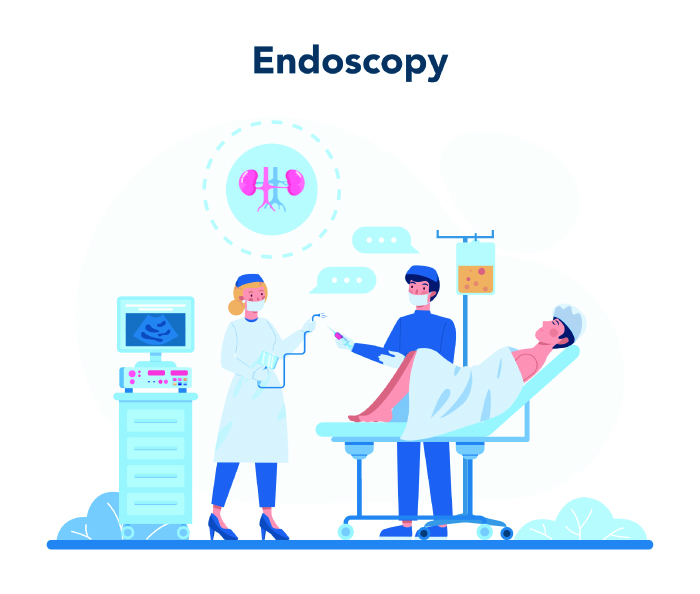Urological endoscopy Treatment & Diagnostics in Chunni Ganj, Kanpur
Urological endoscopy
Urinary tract issues can be not only unpleasant and annoying, but they can also reduce your quality of life. If you're suffering urinary tract issues, your urologist may recommend a urologic endoscopy to assist determine the problem. There are two types of urologic endoscopies:
- Cystoscopy - In this technique, the doctor examines the urethra and bladder with a camera attached to a long tube.
- Ureteroscopy - This procedure involves the doctor looking at your kidneys and ureters (the tubes that link your kidneys to your bladder) using a camera attached to an even longer tube.
These are quick operations that generally last less than an hour.

How Urological endoscopy is performed at Apollo Spectra, Kanpur?
Ureteroscopy is a hospital-based, anesthetic-required technique that is generally performed as an outpatient procedure. A tiny illuminated scope is inserted into the urine. Following are some of the most common causes for a cystoscopy or ureteroscopy:
- Feeling the desire to urinate frequently throughout the day
- Urinary tract infections that recur
- Urine with blood in it
- Urge to urinate as soon as possible
- Urinary discomfort
- being unable to completely empty your bladder
- Leakage of urine
- The search for cancer
A cystoscopy is done under a local anesthetic in the doctor's office. Your doctor will most likely place you under a general anesthetic for the ureteroscopy.
Urethra, bladder, and ureter by your urologist (the tube that drains urine from the kidney to the bladder). Urologists can utilize ureteroscopy to remove stones and detect other reasons for blockage and bleeding. After ureteroscopy, a ureteral stent (a small plastic tube that drains urine from the kidney to the bladder) is sometimes placed to allow for recovery. The stent is removed under local anaesthetic in the office.
Benefits
Endoscopy is a medical technique that allows a doctor to look into a patient's body without having to conduct significant surgery. A long flexible tube having a lens on one end and a video camera on the other is known as an endoscope (fibrescope).
The lens-embedded end of the device is introduced into the patient. The video camera magnifies the area and projects it onto a television screen so the doctor can see what's going on. Light passes down the tube (via bundles of optical fibres) to illuminate the relevant area, and the video camera magnifies the area and projects it onto a television screen so the doctor can see what's going on. An endoscope is usually placed through a natural orifice in the body, such as the mouth, urethra, or anus.
Request an appointment at Apollo Spectra Hospitals, Kanpur
Call 1860-500-2244 to book an appointment
Side effects
Although endoscopy is a reasonably safe technique, it can have certain hazards. The risks vary depending on the region being investigated.
Endoscopy has the following risks:
- Over-sedation, despite the fact that sedation is not always required
- Feeling bloated for a few hours after the procedure minor cramps a numb throat for a few hours owing to the use of local anaesthetic injection of the region of investigation: this most frequently happens when other procedures are performed at the same time. In most cases, the infections are mild and may be treated with medicines.
- In 1 in every 2,500-11,000 cases, persistent discomfort in the region of an endoscopic perforation or rupture of the stomach or oesophagal lining develops.
Who isn't a good ureteroscopy candidate?
- Patients with big stones: Because ureteroscopy necessitates active removal of all or most stone pieces, particularly large stones (>2 cm) may generate so many fragments that full removal is difficult or impossible.
- Patients who have had a urinary tract reconstruction in the past: Patients who have had ureteral or bladder reconstruction may not be able to pass a ureteroscope due to their anatomy.
- Patients who are unable to tolerate stents include: Patients with a history of stent intolerance may be more comfortable with other stone methods because stents are virtually always used after ureteroscopy.
Once your surgery has been confirmed, the required materials will be ordered as needed depending on your age, medical history, and surgical risk.
It is critical that any X-ray films and reports (e.g. CT scans, intravenous pyelogram or IVP, ultrasonography, or MRI) be gathered and presented to your appointment for a thorough examination by your surgeon before your initial clinic session. These films, as well as the radiologist report from the facility that did the X-ray, can be requested from the facility that performed the X-ray. A review of your medical history will be conducted, as well as a physical examination and, if necessary, blood and urine tests.
Symptoms
Our Top Specialities
NOTICE BOARD
CONTACT US
CONTACT US
 Book Appointment
Book Appointment


.svg)
.svg)
.svg)
.svg)








